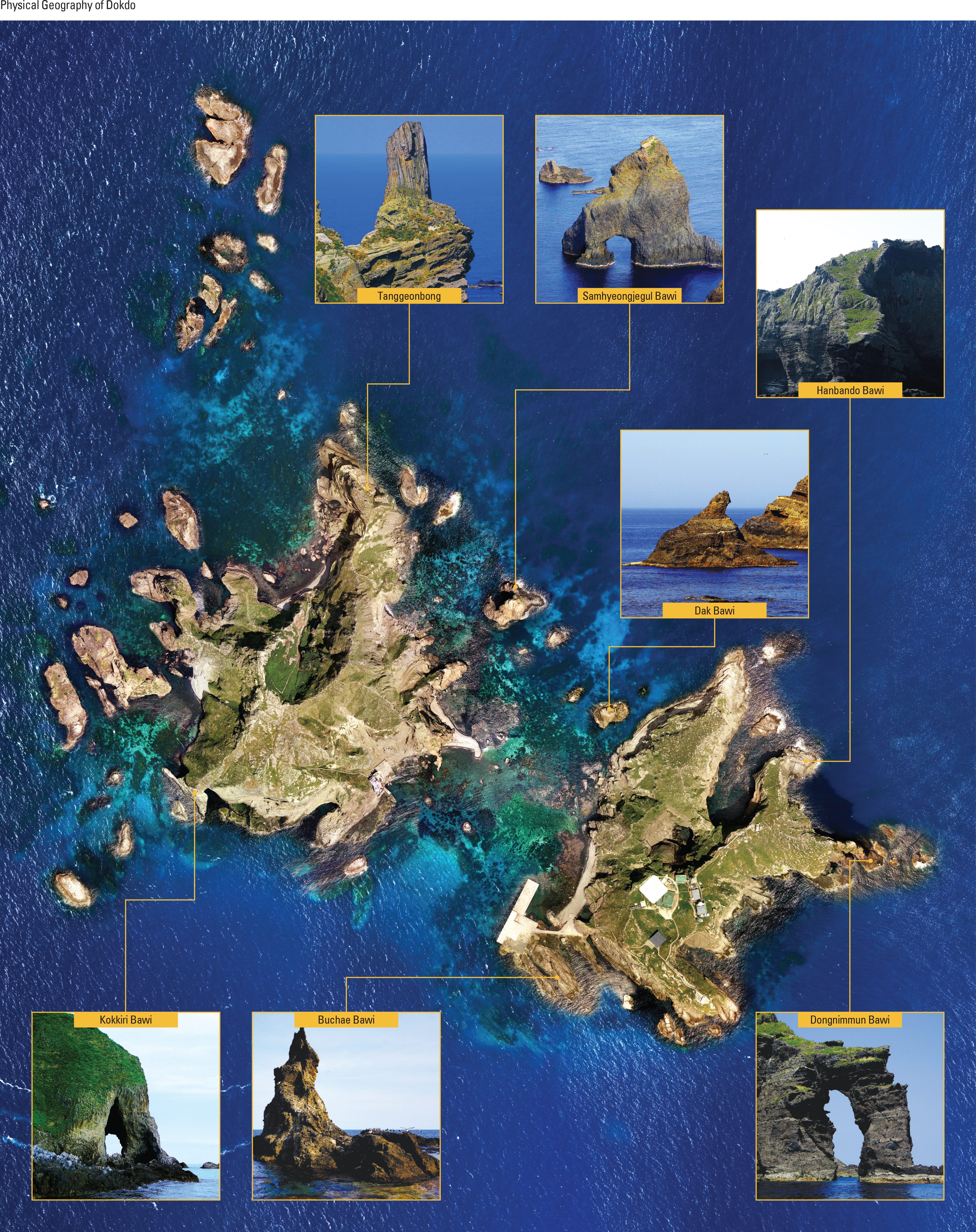Dokdo is an island of the Republic of Korea and is located at the easternmost edge of the national boundary in the East Sea. Dokdo has historically been referred to by various names such as Sambongdo, Gajido, Usando, Jasando and Seokdo. According to Korean historical records, the administrative name of “Dokdo” was first used in 1906 by magistrate Sim Heung-taek of Ulleung. Dokdo was officially incorporated into Gyeongsangbuk-do in 1914.
Dokdo is not one island but consists of two large islands, Dongdo (East Island) and Seodo (West Island), and 89 smaller islands, with a size of 187,554 ㎡. The shortest distance between the two main islands is 151 meters at low tide. Dongdo is located at 37º 14′ 26.8″ N, 131º 52′ 10.4″ E, and Seodo is at 37º 14′ 30.6″ N, 131º 51′ 54.6″ E. Dokdo is 87.4 km east of Ulleungdo and 157.5 ㎞ northwest of Oki Island of the Shimane Prefecture of Japan. Dokdo has been recognized throughout history as part of Ulleungdo, which has itself always been regarded as Korean territory. Both islands are in fact not far apart, and both are visible to one another on a clear day, an observation that was recorded as far back as the early 15th century. In the Sejong sillok jiriji (Geographical Records in the Annals of King Sejong, 1432) it is noted that the two islands of Usan (Dokdo) and Mureung (Ulleungdo) lay within visible distance of one another in the eastern sea of Korea.
The Korean government’s historical archives confirm that Korea has long recognized Dokdo as its territory. Most pointedly, those records provide ample documentation of Korea’s reign of the island. Along with the Sejong sillok jiriji, Sinjeung dongguk yeoji seungnam (the New and Expanded Complete Conspectus of the Territory of the Eastern Country, 1531), Dongguk munheon bigo (Reference Documents on the Eastern Country, 1770), Mangi yoram (Essentials of Governance, 1808), and Jeungbo munheon bigo (Comprehensive Study of Civilization, Revised and Expanded,1908) all include Dokdo in discussions of Korea. In the Reference Documents on the Eastern Country it is recorded that “Ulleung and Usan are part of the State of Usan, and Usan is referred to as Songdo by the Japanese,” reaffirming that Dokdo is Korea’s territory. In 1900, Emperor Gojong of the Korean Empire declared in Ordinance No. 41 that the name of Ulleungdo be changed to Uldo. He then appointed a governor and assigned Uldo to administer Dokdo.
Despite Korea’s longstanding sovereignty over Dokdo, Japan has made more than a few bids to claim the island as a part of its own territory, but even Japanese historical documents reveal that Dokdo has always been a part of Korean territory. In the late 17th century, the Joseon government and Edo Shogunate negotiated an agreement regarding illegal fisheries activities. This was referred to as the “Ulleungdo Dispute.” As a result, the Edo Shogunate officially acknowledged on December 25, 1695 that both Ulleungdo and Dokdo did not belong to the Tottorihan of Edo Shogunate thereby officially confirming that Ulleungdo and Dokdo were not part of Japanese territory. At that point Korea placed a ban on Japanese fishing in the Ulleungdo area. Another prime example of the Japanese acknowledgement of Korea’s sovereignty over Dokdo is the Dajokan Order of 1877. This was an order given by the Dajokan, the highest administrative body of Japan at the time, confirming that Ulleungdo and Dokdo were islands outside of Japan’s territory. In 1905, the Shimane Prefecture Public Notice announced the incorporation of Dokdo into Japanese territory, but this incorporation of Dokdo is widely regarded as a part of the imperialist preamble to the Japanese colonization of the entire Korean Peninsula five years later. Since the end of World War II, the peace process continued to reveal evidence of Korea’s sovereignty over Dokdo. The Cairo Declaration of December 1943 stipulated that “Japan shall be stripped of all islands she has seized or occupied by violence and greed.” The General Headquarters of the Allied Powers issued the instruction code SCAPIN-677 and 1033 in 1946 to exclude Dokdo from Japan’s governmental or administrative control. In addition, the Treaty of San Francisco in 1951 reaffirmed that Dokdo was under Korea’s sovereignty.












